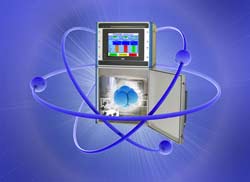

 Water vapour is everywhere
and permeability can dramatically reduce the shelf-life of pharmaceutical, medical and food products. It can de-activate
and contaminate drugs as well as cause medical devices to fail. Yet it
is incredibly useful when, for example, as superheated steam it sterilises
bandages and syringes actually through the packaging.
Water vapour is everywhere
and permeability can dramatically reduce the shelf-life of pharmaceutical, medical and food products. It can de-activate
and contaminate drugs as well as cause medical devices to fail. Yet it
is incredibly useful when, for example, as superheated steam it sterilises
bandages and syringes actually through the packaging.
The vapour (vapour) permeability of Foods, snack and frozen food packaging allows the ingress of water and contaminants causing it to go-off, go-bad, go-stale, go-soggy, loose flavour, loose goodness and loose appeal.
Our equipment is already used by many of the world’s leading manufacturers and our latest range usually provides results in the parts per million (PPM) range, often in as little as 30 minutes. Additionally, the equipment can measure permeability not just for oxygen, but for water vapour, Carbon Dioxide, Nitrogen, Argon and all other relevant gases and vapours.

An additional factor, alongside vapour permeability is the peel-strength and airtightness of any seals, especially those that need to be opened to access the products inside. For more information click here
Permeability plays a major
role for medical and pharmaceutical products and is the critical controlling factor in contamination prevention. Also, the moisture that permeates the protective packaging reduces the potency and shelf life of many drugs
and compounds. Good packaging prevents the drug, dressing or syringe etc from harm, contamination and
reduced efficacy.
For an article on permeability in medical and pharmaceutical applications click here
 For background information on permeability click here
For background information on permeability click here
For background information on Seal Integrity Verification click here
For a press release on pharmaceutical vapour permeability click here
For a press release on the shelf-life of foods click here
for Wikipedia article on shelf-life click here
A good example of the packaging preserving the product is strawberries (or raspberries). These are usually packaged in perforated-top containers. However the fruit “respires” within and the concentration of CO2 rapidly approaches the critical 10-15% level necessary to inhibit Botrytis growth.
This works well, however an alternative approach can make it even better - flushing the package with known gas mixtures and using packaging materials that have been tested for the inward and outward flow - not just of water vapour but of Oxygen, Nitrogen and Carbon Dioxide as well. This maintains the best environment for as long as possible. Normally this involves gas mixes 5-15% CO2, 2-5% O2, with N2 as the remainder. The CO2 generally rises during the first 12 hours and dramatically restricts Botrytis growth.
It is worth taking a very brief look at some of the widely used packaging materials:-
Co-extruded Oriented Polypropylene (COPP): Is a good moisture barrier, gas barrier properties can be improved by coating it with PVdC. It can be used when gas flow is desired for MAP (Modified Atmosphere Packaging).
Ethylene Vinyl Acetate (EVA): Has high flexibility, and high permeability to water vapour and gases with excellent oil and grease resistance.
Ethylene Vinyl Acetate, has superior sealing qualities and blended polyethylene can make a strong peel-able seal.
Ethylene Vinyl Alcohol (EVOH): A moisture sensitive, very high gas-barrier material, often sandwiched.
High Density Polyethylene: with its higher softening point (than LDPE) it provides better a physical barrier buts not suitable as a thermoformable sealant layer, clarity is poor.
High-impact Polystyrene: Opaque, thermoformable, and a moderately low gas-barrier.
Inomers: Are similar to polyethylene but have a high tack and can seal through a level of surface contamination.
Linear Low-Density Polyethylene (LLDPE): This has greater impact and puncture strength, tear resistance, elongation and resistance to cracking. It is commonly used for MAP.
Low Density Polyethylene: An extremely versatile material with low water vapour permeability but high gas permeability.
PET: High clarity that forms and thermoforms well.
Polypropylene (PP) and Oriented Polypropylene (OPP): Gives a high water vapour and gas barrier and has excellent grease resistance.
Polyvinylidene Chloride (PVdC): Used for MAP as a gas-barrier coating, often sandwiched between other materials. It has outstanding barrier properties with low permeability to water vapour and gases.
Using the most appropriate materials can dramatically extend the life of medical, pharmaceutical and food products. However it depends not just the materials you use, but also on the way you make the seals – which can vary even on the same equipment on a daily basis. The best solution is to test the materials, the packaging and the finished products.